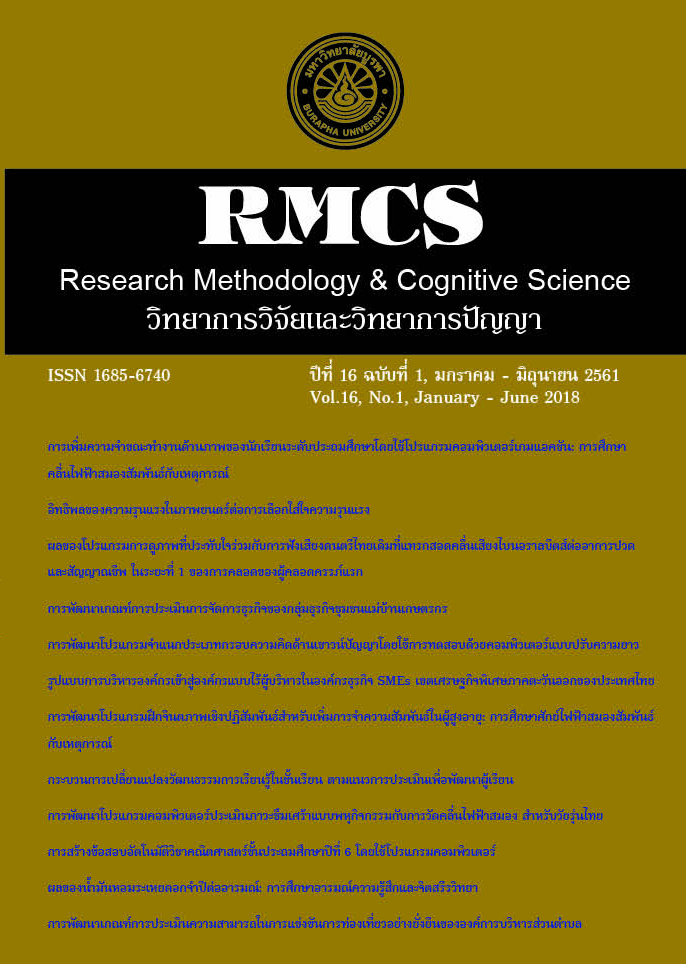ผลของโปรแกรมการดูภาพที่ประทับใจร่วมกับการฟังเสียงดนตรีไทยเดิมที่แทรกสอดคลื่นเสียงไบนอราลบีตส์ต่ออาการปวดและสัญญาณชีพ ในระยะที่ 1 ของการคลอดของผู้คลอดครรภ์แรก
Main Article Content
บทคัดย่อ
ความปวดในระยะคลอดมีอาการรุนแรงมากขึ้นตามความก้าวหน้าของการคลอดและส่งผลกระทบต่อผู้คลอดทุกคน การช่วยให้ผ่อนคลายและลดปวดจึงมีความสำคัญในการดูแลผู้คลอด การวิจัยนี้มีวัตถุประสงค์เพื่อพัฒนาโปรแกรมการดูภาพที่ประทับใจร่วมกับการฟังเสียงดนตรีไทยเดิมที่แทรกสอดคลื่นเสียงไบนอราลบีตส์ และศึกษาประสิทธิผลของโปรแกรมที่พัฒนาขึ้นต่อความปวดและสัญญาณชีพในระยะที่ 1 ของการคลอดของผู้คลอดครรภ์แรกกลุ่มตัวอย่างเป็นผู้คลอดครรภ์แรก จำนวน 60 ราย ที่โรงพยาบาลพระจอมเกล้า จังหวัดเพชรบุรี เลือกแบบเจาะจงตามคุณสมบัติที่กำหนด แบ่งเป็นกลุ่มทดลองที่ 1 ได้รับโปรแกรมการดูภาพที่ประทับใจร่วมกับการฟังเสียงดนตรีไทยเดิมแทรกสอดด้วยคลื่นเสียงไบนอราลบีตส์ 20 ราย และกลุ่มทดลองที่ 2 ซึ่งได้รับโปรแกรมการดูภาพที่ประทับใจร่วมกับการฟังเสียงดนตรีไทยเดิมที่ไม่ได้แทรกสอดคลื่นเสียงไบนอราลบีตส์ 20 ราย และกลุ่มควบคุมได้รับการดูแลตามปกติ 20 ราย ทำการวัดคะแนนความปวดและสัญญาณชีพก่อนการทดลอง หลังการทดลองทันที และ 30 นาที หลังการทดลอง เครื่องมือที่ใช้ในการทดลอง ประกอบด้วย โปรแกรมการดูภาพที่ประทับใจร่วมกับการฟังเสียงดนตรีไทยเดิมแทรกสอดกับไม่แทรกสอดคลื่นเสียงไบนอราลบีตส์ วิเคราะห์ข้อมูล ด้วยสถิติ Chi-square และความแปรปรวนพหุคูณแบบวัดซ้ำ
ผลการวิจัยปรากฏว่า 1) โปรแกรมที่พัฒนาขึ้นประกอบด้วยกิจกรรมการดูภาพที่ประทับใจร่วมกับการฟังเสียงดนตรีไทยเดิมแทรกสอดคลื่นเสียงไบนอราลบีตส์ ใช้ระยะเวลา 30 นาที สามารถช่วยผ่อนคลาย ลดปวดและสัญญาณชีพในระยะคลอดได้ 2) ค่าเฉลี่ยความปวดของกลุ่มทดลองที่ 1 ในระยะหลังการทดลองทันที และ 30 นาทีหลังการทดลองต่ำกว่ากลุ่มทดลองที่ 2 และกลุ่มควบคุม อย่างมีนัยสำคัญทางสถิติที่ระดับ .05 และ 3) สัญญาณชีพของกลุ่มทดลองที่ 1 หลังการทดลองทันทีต่ำกว่ากลุ่มทดลองที่ 2 และกลุ่มควบคุม อย่างมีนัยสำคัญทางสถิติที่ .05 และ 4) ค่าเฉลี่ย
ความปวดของกลุ่มทดลองที่ 2 ในระยะหลังการทดลองทันทีต่ำกว่ากลุ่มควบคุมอย่างมีนัยสำคัญทางสถิติที่ .05
Article Details
เอกสารอ้างอิง
ศศิธร พุ่มดวง. (2551). การลดปวดในระยะคลอดโดยไม่ใช้ยา. (พิมพ์ครั้งที่ 2). กรุงเทพฯ: อัลลายด์เพรส.
Abushaikha, L., & Oweis, A. (2005). Labour pain experience and intensity: a Jordanian perspective. International
Journal of Nursing Practice, 11(1), 33-38.
de Tommaso, M., Calabrese, R., Vecchio, E., Francesco, V. D. V., Lancioni, G., & Livrea, P. (2009). Effects of affective pictures on pain sensitivity and cortical
responses induced by laser stimuli in healthy subjects and migraine patients. International Journal of Psychophysiology, 74(2), 139-148.
Edmonds, W. A., & Kennedy, T. D. (2017). An applied guide to research designs: Quantitative, qualitative, and mixed methods(2 nd ed.). California: Sage Publications.
Evans, D. (2002). The effectiveness of music as an intervention for hospital patients: a systematic review. Journal of Advanced Nursing, 37(1), 8-18.
Johnsen, E. L., Tranel, D., Lutgendorf, S., & Adolphs, R. (2009). A neuroanatomical dissociation for emotion induced by music. International Journal
of Psychophysiology, 72(1), 24-33.
Johnson, M. H. (2005). How does distraction work in the management of pain?. Current Pain and Headache Reports, 9(2), 90-95.
Kenntner-Mabiala, R., & Pauli, P. (2005). Affective modulation of brain potentials to painful and nonpainful stimuli. Psychophysiology, 42(5), 559-567.
Labor, S., & Maguire, S. (2008). The pain of labour. Reviews in Pain, 2(2), 15-19.
Liu, Y. H., Chang, M. Y., & Chen, C. H. (2010). Effects of music therapy on labour pain and anxiety in Taiwanese first-time mothers. Journal of Clinical
Nursing, 19(7-8), 1065-1072.
Lowdermilk, D. L., & Perry, S. E. (2006). Anatomy and physiology of pregnancy. Maternity Nursing, 208-230.
Melzack, R., & Katz, J. (2004). The gate control theory: Reaching for the brain. Pain: Psychological Perspectives, 13-34.
Padmanabhan, R., Hildreth, A. J., & Laws, D. (2005). A prospective, randomised, controlled study examining binaural beat audio and pre-operative anxiety in patients undergoing general anaesthesia for day case surgery. Anaesthesia, 60(9), 874-877.
Perry, S. E., Hockenberry, M. J., Lowdermilk, D. L., & Wilson, D. (2013). Maternal child nursing care (5th ed.). Missouri: Elsevier Health Sciences.
Rhudy, J. L., Bartley, E. J., & Williams, A. E. (2010). Habituation, sensitization, and emotional valence modulation of pain responses. Pain, 148(2), 320-327.
Rhudy, J. L., Williams, A. E., McCabe, K. M., Russell, J. L., & Maynard, L. J. (2008). Emotional control of
nociceptive reactions (ECON): do affective valence and arousal play a role?. Pain, 136(3), 250-261.
Roy, M., Piché, M., Chen, J. I., Peretz, I., & Rainville, P. (2009). Cerebral and spinal modulation of pain by emotions. Proceedings of the National Academy
of Sciences, 106(49), 20900-20905.
Weber, A., Werneck, L., Paiva, E., & Gans, P. (2015). Effects of music in combination with vibration in acupuncture points on the treatment of fibromyalgia. The Journal of Alternative and Complementary Medicine, 21(2), 77-82.
Wiwatwongwana, D., Vichitvejpaisal, P., Thaikruea, L., Klaphajone, J., Tantong, A., & Wiwatwongwana, A. (2016). The effect of music with and without
binaural beat audio on operative anxiety in patients undergoing cataract surgery: a randomized controlled trial. Eye, 30(11), 1407-1414.
Zampi, D. D. (2016). Efficacy of Theta Binaural Beats for the Treatment of Chronic Pain. Alternative Therapies in Health and Medicine, 22(1), 32-38.

